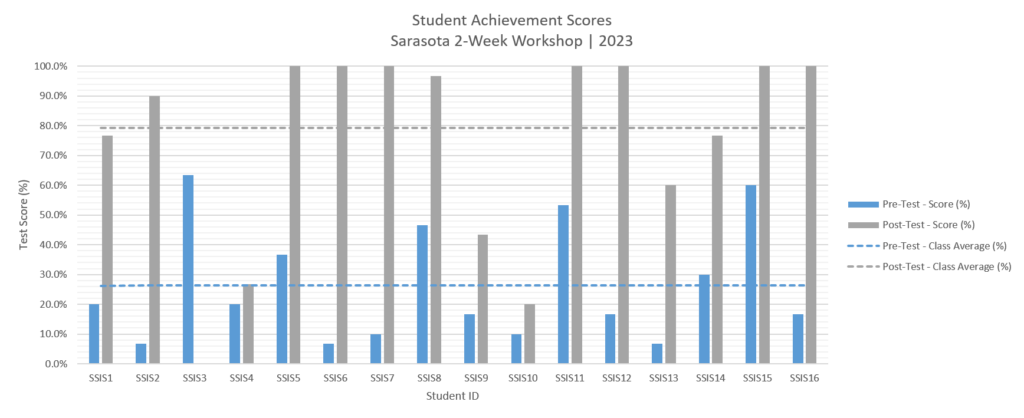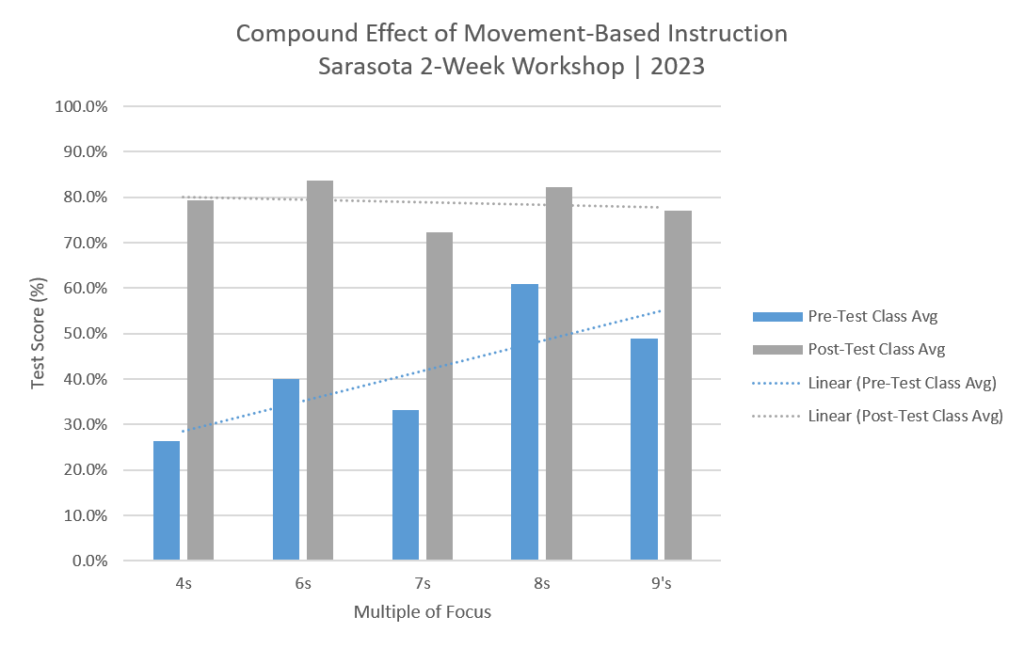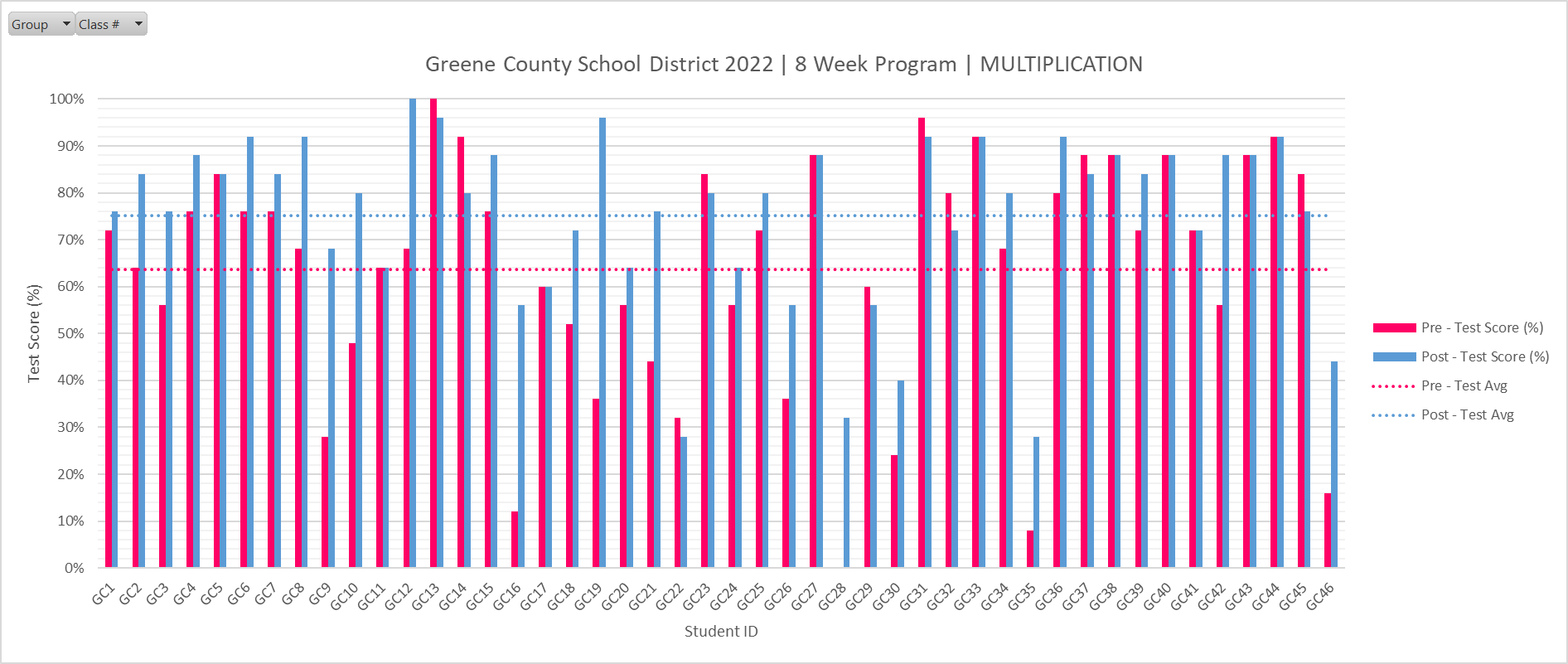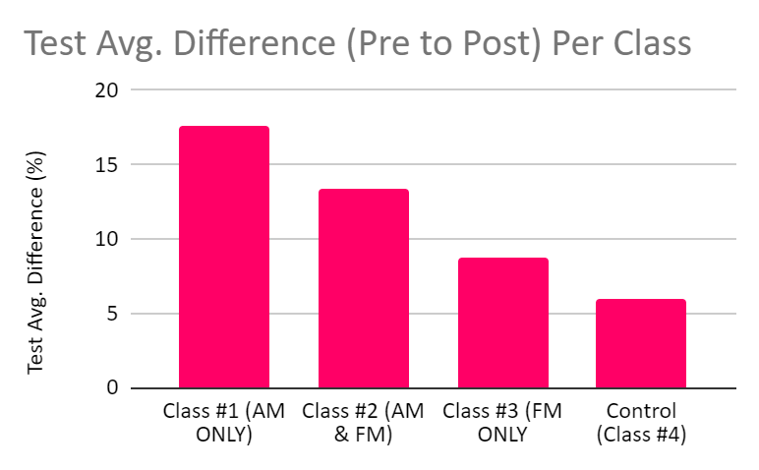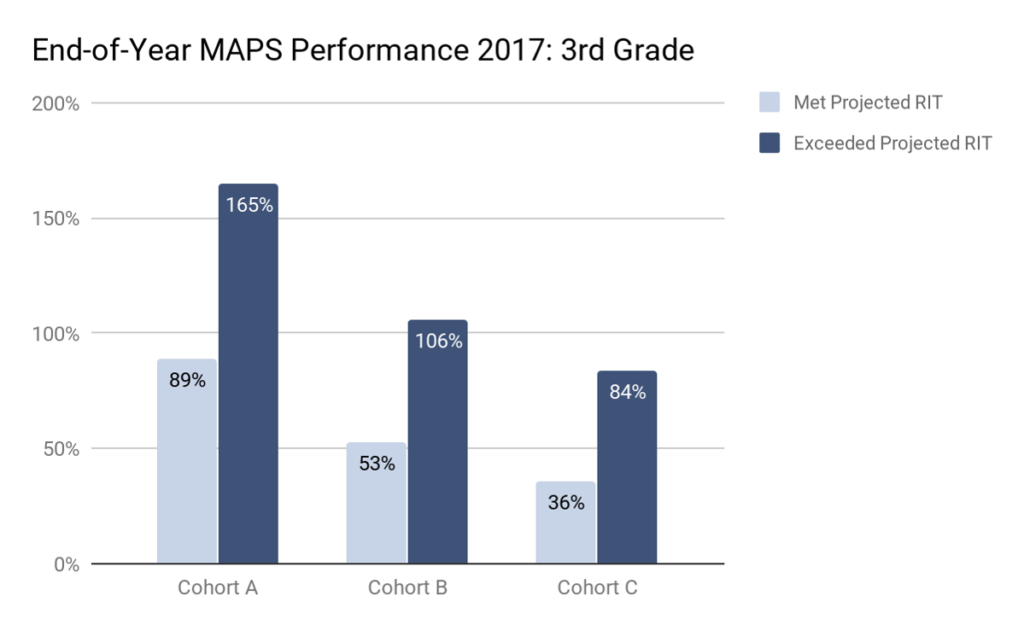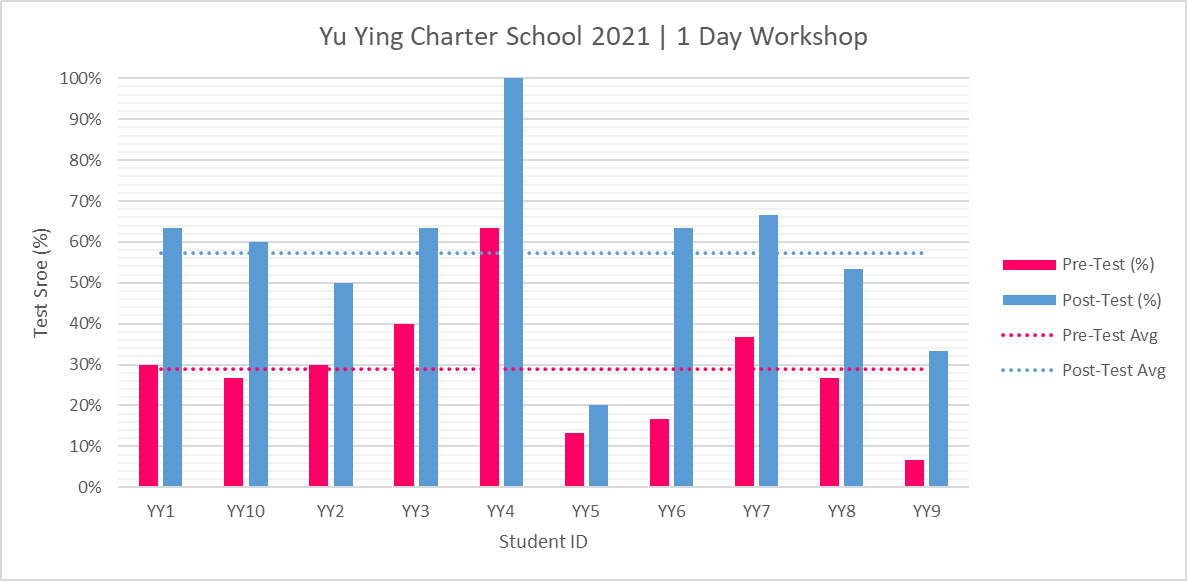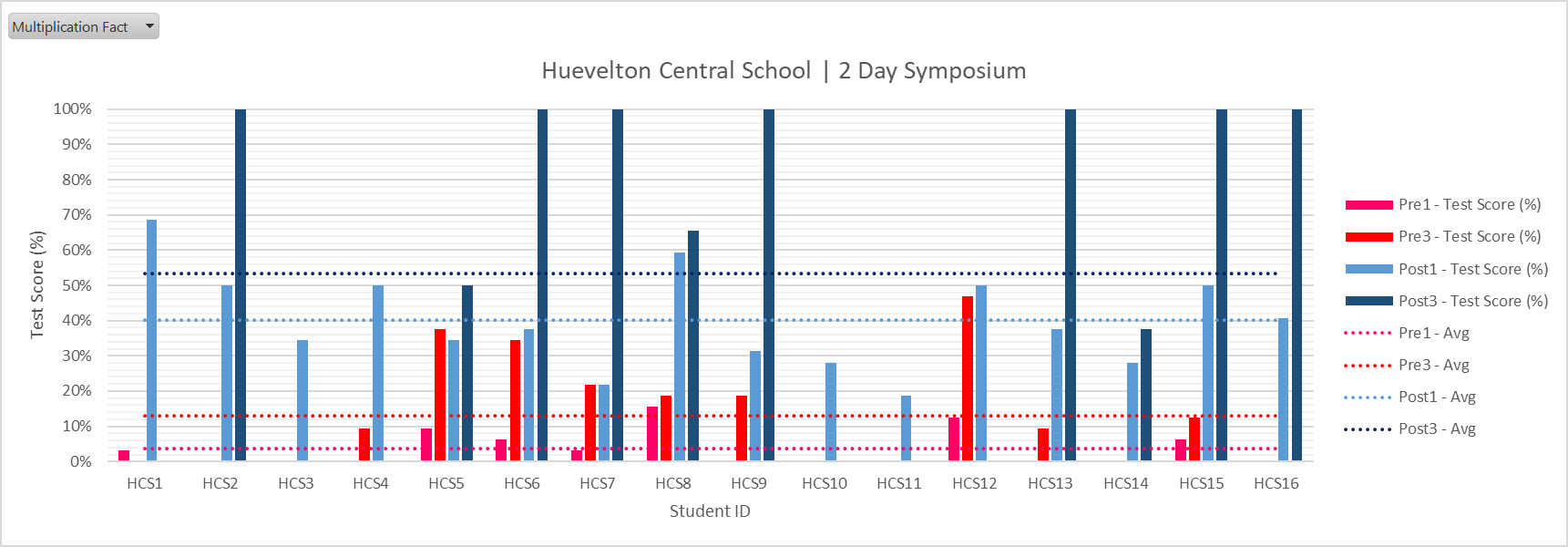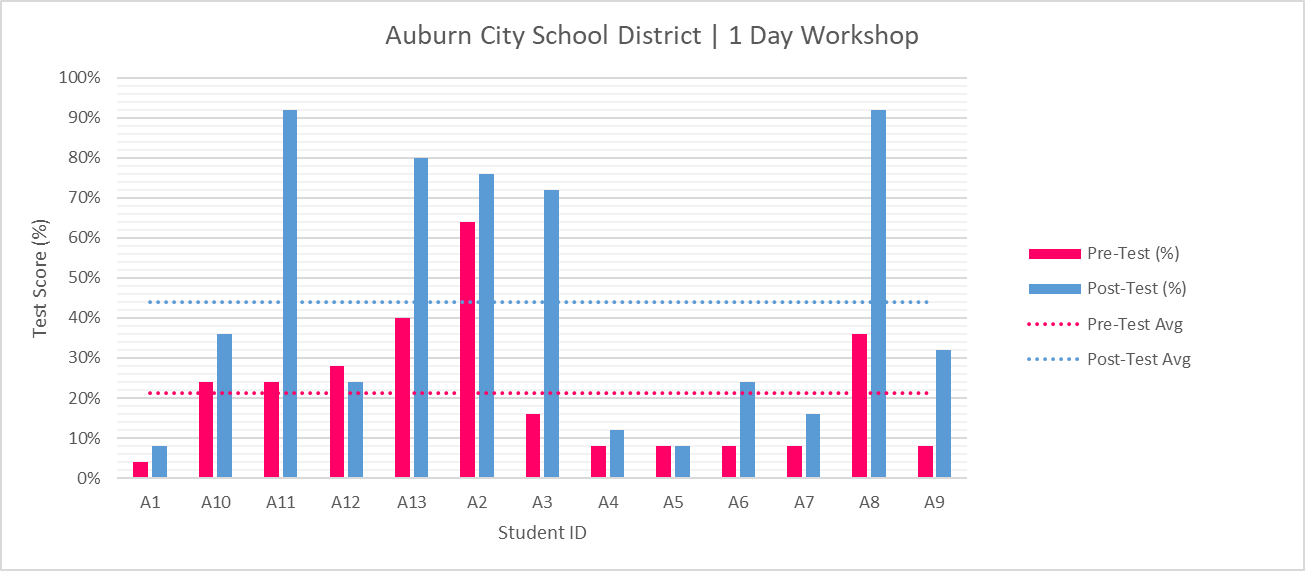Individual Classroom Data
- Suncoast School for Innovative Studies
- Greene County School
- Gilbertsville-Mount Upton Central School
- Davidson Elementary
- Yu Ying Charter School
- Benton Hall Academy
- Heuvelton Central School
- Auburn Central School
- JD George Elementary
- Linden Elementary
Project Date: Apr. 2023 | Project Location: FL
Project Leader(s): Suzy Koontz (Learn Thru Movement, Inc.), Fayth Jenkins (Director of Suncoast School)
______________
Introduction
Suzy Koontz, founder and CEO of Math & Movement, led a group of 3rd grade students in activities to develop fluency with multiplication, division, telling time, place value, word problems, rounding, area, and more.
Purpose of Study
SSIC has included Math & Movement activities for two years in their curriculum. This opportunity for SSIC offers additional professional development for SSIC educators and demonstrates movement-based learning with students.
Participants
14 Students | 3rd Grade
Project Resources
The intervention included the Math & Movement Skip Counting hopping mats for 3’s, 4’s, 5’s, 6’s, 7’s, 8’s, 9’s and 12’s, the Add/Subtract mat, and the books “Jump and Learn Multiplication” and “Multiplication and Division in the Real World”
Project Timeline
April 24-28 at 9:50 AM-11:30 AM and 1:45 PM-3:30 PM.
Methodology
A focus on numerous fundamental math concepts including multiplication, division, telling time, place value, word problems, rounding, area, etc.; Students were pre-tested before they began working with the materials/movements and post-tested after the project was completed. Mrs. Koontz also interviewed students and the classroom teacher before the project commenced and after the project was completed.
Results/Outcomes
Students saw significant improvement in their multiplication skills through their participation in the intervention. Additionally, the positive trend in multiplication pre-tests indicates a cumulative effect of movement-based strategies on students’ solving of multiplication problems
Project Date: Jan. 2022 | Project Location: TN
Project Leader(s): Hailey Parente, MPH (East Tennessee State University), Valerie Walters, MA (Greene County Schools Health Coordinator), Jennifer Gunter (4th Grade Math Teacher)
______________
Introduction
Hailey Parente (MPH), partnered with Jennifer Gunter at Greene County Schools and Valerie Walters (MA), led the multiplication-focused intervention; the projects leads consulted Kirby Schoephoerster (MA) at the National Math Foundation for project development and logistics resources to carry out the project. Hailey used both active math movements and skip counting floor mats designed by Math & Movement to determine a kinesthetic approach’s effectiveness on student behavior and math outcomes. Jennifer was trained in how to use the materials, and Valerie led the sessions virtually/in person in collaboration with Hailey. Students were pre-tested before they began working with the materials/movements; the materials/movements were integrated into the multiplication units for 2 of the 3 classes.
Purpose of Study
To determine the effect(s) of active math movements on stressed students and the difference physically active math games can make in the calming-down of unwanted behaviors.
Participants
46 Students | 4th Grade
Project Resources
Math & Movement’s Multiplication Floor Mat Package + Digital Resources
Methodology
A focus on multiplication; teachers utilized both active math movements and skip counting floor mats to determine math outcomes. Ms. Gunter was trained in how to use the materials, and Ms. Walters and Parente led the sessions virtually/in person. Students were pre-tested before they began working with the materials/movements and post-tested after the project was completed. The materials/movements were integrated into the multiplication units for 3 of the 4 classes. Class #1 engaged with active math movements only, while Class #3 utilized kinesthetic floor mats only. Class #2 utilized both active math movements and floor mats. The class that did not integrate the program (Class #4) functioned as the Control Group. Students utilized the movement-focused program for only 30 minutes per week. The project lasted 8 weeks.
Results/Outcomes
Prior to the project, Ms. Gunter stated that her afternoon class (Class #3) not only struggled the most with math content, but also had less time in class per day to practice math concepts. Such variables could have affected the math outcomes seen in Class #3 relative to the other classes.
Project Date: Feb. 2023 | Project Location: NY
______________
Purpose of Study
To determine the effectiveness of the Math & Movement program after its incorporation into a one-hour math lesson at Gilbertsville-Mount Upton Central School.
Participants
12 Students | 3rd Grade
Project Resources
Math & Movement’s Skip Counting by 8’s Floor Mat
Methodology
Suzy Koontz Zoomed into the classroom for about 1 hour. At the start of the session, students completed a 2 page multiplication by 8’s pre-test. After the test, students completed 1 “Math Movement” (Soccer by 8’s), then they jumped on the Skip Counting by 8’s floor mat. Each student had a turn jumping on the mat. Students completed one more math movement (Basketball by 8’s) just before the post-test. |
Results/Outcomes
The teacher was very engaged and enthusiastically encouraged students to chant loudly the skip counting while each of the students had a turn jumping. It seems that such an activity may be helpful for students to do before a post-test.
The participating teacher had taught her students a skip counting by 8’s song to the tune of a familiar song. She encouraged students to jump on the mat while they sang their song. The students began the session with a solid knowledge of skip counting that was acquired from lots of practice singing the song.
Note that the song was just the numbers and, therefore, did not have any one words. The students began the session with a solid knowledge of skip counting that was acquired from lots of practice singing the song.
Both Suzy and the participating teacher were surprised that these scores are so good considering the small amount of practice.
Project Date: 2017 | Project Location: NC
______________
Purpose of Study
The mission of the project was to improve the mathematical understanding of Dividson Elementary’s diverse population of 706 students K-5th grade.
Davidson’s goal in adopting Math & Movement is providing continuous and excellent child centered instruction and improving individual student growth across all demographics and academic levels: to decrease the gap in student achievement of our subgroups, address student weaknesses, build off student strengths, and guide every child towards a path of academic success for the next grade level.
Participants
706 Students | 3rd Grade + additional K-2nd Grade Classrooms
Project Resources
Math & Movement’s Comprehensive Package (includes math-focused floor mats and reading/digital resources)
Methodology
In 2 of the third grade classrooms (43 students), project leads implemented the program consistently with teacher instruction and lessons throughout the school year; this group was labeled as “Cohort A”. Lessons, math stations, interventions, and math warm-ups were done regularly using the materials with all students.
2 other third grade classrooms (40 students) used the program inconsistently and more as a resource to enhance
student learning; this group of students was identified as “Cohort B”. Floor mats and wall banners were available to students, but with less explicit instruction.
The remaining third grade classrooms did not participate in the project (40 students); this group was labeled as “Cohort C”.
Some teachers used wall banners during transitional times in the hallways. Students would practice the skip counting patterns and do hand movements to strengthen multiplication and division skills. This was cited as a useful method to extend learning outside of the classroom.
The Math & Movement materials were also used as interventions for some students. If students needed to practice addition and subtraction to 20, for example, they would use the 0-20 floor mat and move, write, and say the math facts.
Teachers were able to sign-out specific materials purchased for the project through a Google Docs sign-out. Teachers would sign-out floor mats based on a particular unit of study, or to use in small groups.
Results/Outcomes
The End-of-Year MAPS (Measure of Academic Progress scores) for each Cohort Group of third graders is listed below. The data represents the number of students who met or exceeded their projected RIT score (A RIT score is an estimation of a student’s instructional level and measures student progress or growth).
The data suggests that those students who may have had more opportunities to use the program, in addition to other math instruction and materials, made higher growth gains in mathematics. It was apparent that using all three learning modalities improved student understanding and memory.
The teachers who used the Math & Movement program said students were always active and engaged in his/her learning while using the materials. The visually appealing materials and ability to move, positively impacted children who were less confident or typically non-engaged in math.
Project Date: Nov. 2022 | Project Location: Washington, DC
______________
Purpose of Study
To determine the effectiveness of the Math & Movement program after its incorporation into a one-hour Yu Ying math lesson.
Participants
10 Students | 4th Grade
Project Resources
Math & Movement’s Skip Counting by 6’s Floor Mat
Methodology
The entire program was approximately 40 minutes. Both the pre-test and the post-test had 30 multiplication by 6s problems. Pre-testing was done verbally by having the students collectively skip count by 6’s.
The program began with warm-up math movements. Students counted from 1 to 60 whispering the numbers that are not the multiples of 6 and shouting the multiples of 6. Next, the students lined up on the skip counting by 6s mat. Each student had the opportunity to jump on the mat while they chanted the multiples of 6.
Students on the sidelines jumped and chanted their 6’s. After each student had had a turn on the mat, the project lead had them turn away from the mat and skip count together by 6s. Students took turns jumping on the mat again while they collectively skip counted by 6s.
Periodically, the project lead would gauge student improvement by asking them to turn away from the mat and collectively skip count by 6s without looking at the mat. Each time the lead would ask students if they recognized their own personal growth.
Students took turns solving multiplication problems by 6’s using the Skip Counting by 6’s floor mat. Students received a page of multiplication problems by 6’s and were encouraged to use the mat to find the answers. Students then worked independently, jumping on the mat to count the groups of 6’s and documenting their work on their work pages.
Results/Outcomes
Project Date: May 2016 | Project Location: NY
______________
Purpose of Study
To determine the effectiveness of the Math & Movement program after its incorporation into Benton Hall Academy’s math curriculum.
Participants
16 Students | 2nd Grade level
Project Resources
Math & Movement’s Skip Counting by 3’s Floor Mat + Digital Resources for Multiplication
Methodology
The students at Benton Hall Academy worked one-on-one with teachers for approximately 90 minutes over two days. Pre- and post-tests were completed from memory without the use of any floor mats or banners.
Results/Outcomes
On the pre-test, many of the 2nd grade students did not know any of the multiplication by 3’s problems. On the post-tests, 56% of the students had nearly all 32 multiplication by 3’s problems answered correctly.
The teachers observed that Math & Movement activities increased student focus and determination in completing the math problems.
Many teachers commented about their students’ transformation from indifference to enthusiasm towards math practice. They noticed an increase in student self-confidence.
The teachers commented that the students learned how to use the floor mats as a tool to consistently determine the correct answer.
The teachers commented that the students learned how to use the floor mats as a tool to consistently determine the correct answer. One student that was identified as a struggling second grade student became absorbed in solving the multiplication problems. He continued to work independently with great focus and determination for the allotted time period, without support from his teacher. According to his teacher, this student requests regular movement breaks in the classroom and has challenges focusing without the breaks.
Project Date: Jun. 2016 | Project Location: NY
______________
Purpose of Study
To determine the effectiveness of the Math & Movement program after its incorporation into Heuvelton Central School’s math curriculum.
Participants
16 Students | Misc. grades
Project Resources
Math & Movement’s Skip Counting by 3’s Floor Mat
Methodology
During this symposium, students worked one-on-one with teachers for approximately 90 minutes over two days. Both the pre- and post-test were completed without the use of any floor mats or banners. During these trials, students were tested after both one minute of activity and after three minutes of activity to show prolonged results.
Results/Outcomes
Teachers reported that many students found the activities enjoyable and were willing to continue to solve math problems.
The level of focus displayed while engaging in Math & Movement during the Symposium has rarely been exhibited in the classroom. One student was on school suspension because she was so disruptive in class. At the Symposium, she worked consistently on solving the math problems.
Project Date: Nov. 2022 | Project Location: NY
______________
Purpose of Study
To determine the effectiveness of the Math & Movement program after one hour of its incorporation into Auburn Central School District’s math curriculum.
Participants
13 Students | 4th Grade
Project Resources
Math & Movement’s Skip Counting by 6’s Floor Mat
Methodology
Students worked for 55 minutes on skip counting and multiplication by 6’s. The pre-and post-tests were identical and contained 25 multiplication problems focusing on only one multiplication fact (i.e., 6’s). In both tests, students had one minute to solve as many problems as they could.
Results/Outcomes
Project Date: Nov. 2015 | Project Location: NY
______________
Purpose of Study
To determine the effectiveness of the Math & Movement program after its incorporation into JD George Elementary’s math curriculum.
Participants
15 Students | 3rd Grade
Project Resources
Math & Movement’s Skip Counting by 3’s Floor Mat
Methodology
At this symposium, third grade students worked with teachers for four sessions over a two-day period. The pre-and post-tests were identical and contained 32 multiplication problems focusing on only one multiplication fact. In both tests, students had one minute to solve as many problems as they could.
Results/Outcomes
Project Date: Dec. 2015 | Project Location: TN
______________
Purpose of Study
To determine the effectiveness of the Math & Movement program after its incorporation into Linden Elementary’s math curriculum.
Participants
19 Students | Misc. grades
Project Resources
Math & Movement’s Skip Counting by 3’s Floor Mat
Methodology
During this symposium, students worked one-on-one with teachers for approximately 90 minutes over two days. The intervention consisted of three sessions of teachers working with the students. Both the pre- and post-test were completed without the use of any floor mats or banners.
Results/Outcomes


